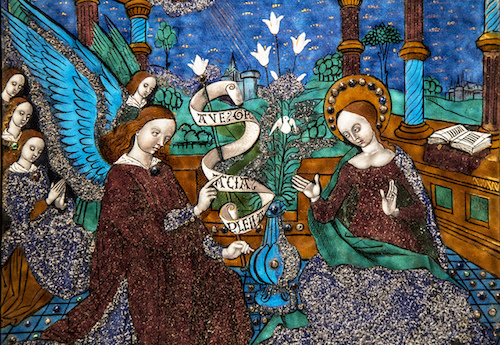We run our website the way we wished the whole internet worked: we provide high quality original content with no ads. We are funded solely by your direct support. Please consider supporting this project.

Why Believe the Virgin Birth Accounts?
Some skeptics claim that the story of the virgin birth of Jesus is derived from similar stories from pagan literature. While I won’t address here the details of the various parallels that some use to argue this point—as it has been demonstrated by many scholars that they simply don’t hold up to scrutiny—I will offer four reasons why I trust that the Bible’s account of the virgin birth is trustworthy and thereby reject this pagan-origin theory as bogus.
- It’s extremely unlikely that the early Christians who were largely first century, orthodox, Palestinian Jews would borrow material from pagan stories. All the historical evidence indicates that Palestinian Jews were strongly resistant to pagan stories and practices.
- Unlike the pagan stories, the accounts that are included in the Gospel were not about someone who lived “once upon a time,” but someone who lived in the very recent past and in the region where the story was originally being told. Even if the earliest Jewish Christians would have been capable of incorporating pagan legends into their proclamation, it’s hard to see how they could have plausibly done this while Jesus’ brother and mother along with others who knew him were still alive. (I would argue that both Matthew and Luke were written prior to 70 AD, but even if one accepts a later dating of 70 to 90 AD this is still very close to the event by historical standards. Plus, we must remember that the Gospel material was passed on and protected orally before being written. On the importance of oral traditions in non-literate cultures, see Eddy, Boyd, The Jesus Legend).
- Unlike any other literature that contains alleged supernatural conceptions, Matthew and especially Luke give us many historical reasons for accepting their general historicity (here too, see The Jesus Legend). The infancy narratives of Jesus in particular bear all the marks of reports that go back to the earliest witnesses.
- The alleged parallels of these pagan stories to the Gospel accounts of Jesus’ conception are simply not very impressive. There are, of course, numerous accounts of gods having sex with each other to produce a divine mythic hero and even some accounts of a male god having intercourse with a woman to produce a partly divine hero. But these supposed parallels actually lack one key thing: virginal conception. The divine or human females had sex! So far as I know, there are three possible exceptions to this (Krishna, Buddha and the son of Zoroaster), but even in these accounts it’s a stretch to say they parallel the Gospel accounts of a seed being created ex nihilo and planted in the womb of a woman who had never had sex. In addition, we have absolutely no historical reasons for thinking any of these accounts is at all rooted in history or that the earliest Christians knew about them – let alone borrowed from them.
Of course, none of this proves that Mary supernaturally conceived Jesus while remaining a virgin. The nature of the subject is that it’s impossible to prove (true or false). And, I should add that my faith in Christ doesn’t hang or fall on the historicity of this particular story. At the same time, I find I have many compelling historical (as well as existential and philosophical) reasons for accepting the general portrait of Jesus in the Gospels, and since the story of Jesus’ virginal conception is part of this broader story, I believe it to be true.
Photo credit: Lawrence OP via Visualhunt.com / CC BY-NC-ND
Category: General
Tags: Apologetics, Jesus, Reliability of the Gospels
Related Reading

Is Jesus Really God?
While it is true that Jesus Himself never comes out and explicitly says He is God in the Gospels, He is everywhere portrayed in terms that lead us to conclude to the same thing. He says things like “If you see Me, you see the Father,” “Honor Me even as you honor the Father,” and…

Satan and the Corruption of Nature: Seven Arguments
Man…trusted God was love indeed And love Creation’s final law – Tho’ Nature, red in tooth and claw With ravine, shrek’d against his creed” —Tennyson, In Memoriam Tennyson nailed it. We trust that God is love, but we also believe that God is the Creator of nature, and nature simply does not seem to point…

Parable of the Jerk Loser Son
Birmingham Museum and Art Gallery via Compfight Peter Enns blogged about the parable of the prodigal son, or as he likes to call it, “the parable of the jerk loser son.” It’s actually a reflection about the unbelievable and scandalous love of God. I guarantee it will bless you. From the article: The story isn’t about…

Participating in the Divine Nature (Love)
When God created the world, it obviously wasn’t to finally have someone to love, for God already had this, within himself. Rather God created the world to express the love he is and invite others in on this love. This purpose is most beautifully expressed in Jesus’ prayer in John 17. Jesus prays to his…

Lighten Up: The Jesus Eraser
“For he himself is our peace, who has made the two groups one and has destroyed the barrier, the dividing wall of hostility…” Ephesians 2:14 Image by David Hayward @ www.nakedpastor.com.

God’s Favor, Not Vengeance
Jesus began his ministry with a brief sermon in his hometown synagogue. Quoting Isaiah 61, Jesus said, The Spirit of the Lord is on me, because he has anointed me to proclaim good news to the poor. He has sent me to proclaim freedom for the prisoners and recovery of sight for the blind, to…
